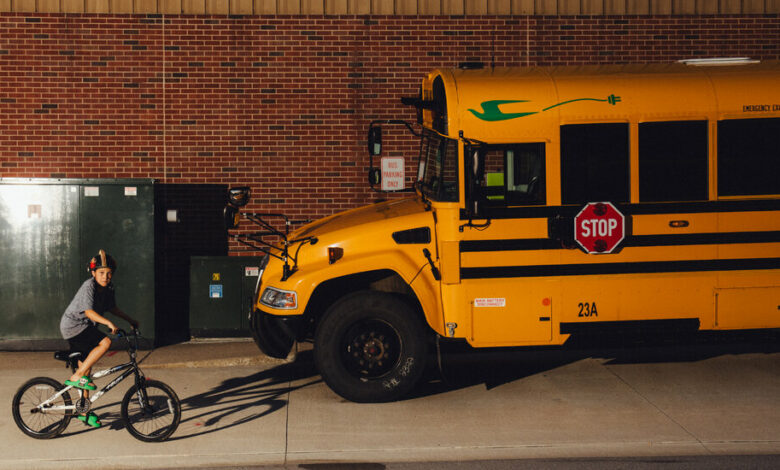A Brand-New Electric Bus, No Charge. (That Was One Problem.)

The matter before the school board was straightforward. The tiny school district in Wymore, Neb., needed a new school bus to replace one so old and beat-up that it was used only to ferry the football team back and forth to the practice field a few blocks away.
The new bus would be larger than the old one, board members learned at the meeting 18 months ago, and also totally free, thanks to a federal grant. But the biggest difference: The new bus would be powered not by a diesel engine but by electricity.
The bus didn’t stir up much discussion that first meeting, recalled Christopher Prososki, the superintendent, who’s known around town as Dr. P.
“A free bus is a free bus,” he said.
But this bus wasn’t like the others.
Kids who rode it for the first time said it made a whirring sound like a U.F.O. Its driver said the hum reminded him of the Flying Car in The Jetsons. The school board president nicknamed it “the Biden bus,” annoying the superintendent.
As the months passed in Wymore, a town of about 1,300 nestled in the plains, the electric bus became a surrogate for far bigger issues this quiet corner of the nation is facing. In conversations in the school boardroom, at the volunteer fire hall and at the American Legion bar, the bus exposed fears of an unwelcome future, one where wind turbines tower across the flatlands, power generated by Nebraska solar farms is sent out of state and electric cars strand drivers on lonesome gravel roads.
Changes like these were bound to cause new headaches or worse in this part of the country, upsetting a comfortable and familiar way of life, some residents said. “We’ll fight it tooth and nail,” said John Watts, who worries that an all-E.V. future would jeopardize his 40-acre salvage yard just outside town that specializes in parts for muscle cars.
I took a special interest in reaction to the new school bus because Wymore is my hometown, too: John Watts was my high school classmate. So was David Zimmerman, now a family farmer a few miles from town and president of the school board. When I called to ask him about the bus, he answered the phone like this:
“You’re not going to tell me my cows are farting too much and polluting the atmosphere, are you?”
The railroad glory days
Most people whiz past Wymore on Highway 77 without stopping. There’s not much reason to linger. Downtown streets are still paved in brick, as they’ve been for 100 years, but the gaps where businesses once stood — the Grand Theatre, the Narrow Gage cafe — give Main Street the look of a mouth that’s missing a few teeth.
It wasn’t always like this.
The railroads made Wymore. There were hotels and restaurants and residents who traveled about by electric tram. Champagne music maestro Lawrence Welk once performed at a dance pavilion on the outskirts of town. My grandparents had their first date, a screening of an early talkie, at one of the downtown movie theaters.
Even in a railroad town like Wymore, the car became king. Camaros kicked off parades. Old convertibles delivered homecoming queens to their kings. At his used car shop in the adjoining community of Blue Springs, Fuzz Morris towed Monte Carlos and El Caminos that went into ditches along country lanes.
By the 1970s and 1980s, when I was growing up there, the town was shriveling as trains were making their final runs and the old depot was burned down for a firefighting exercise. My friends and I still cruised the sleepy three-block main drag in mindless circles, my T-top Ford Mustang serving as disco, restaurant and clubhouse.
Back then, my classmate John Watts was driving his hot rod, a 1965 Chevy Impala SS, through town with quiet purpose, rarely stopping to chat and dreaming of the day he would run his own salvage yard.
David Zimmerman was there, too, an apple-cheeked football player also destined to build a future in Wymore. Today he runs a family farm just past the edge of town where he and his sons grow corn and soybeans and tend a herd of 103 cattle. His wife teases him for getting so attached to his animals that he sometimes keeps one or two from going to market.
He gives back to the community by serving on the school board, where he didn’t exactly welcome Wymore’s new electric bus.
Time for a new bus
School officials knew they needed to replace the oldest bus in their fleet of seven, a 1999 yellow monster that roared and had seen better days. But money was tight at Wymore’s tiny Southern School District, which graduated 27 students this year.
Dr. Prososki, a former social studies teacher with boyish looks, a physique that gives off gym-coach vibes and a Ph.D. in education, offset his small budget by finding grants to fund everything from weight-room equipment to a program to teach welding. He switched the district’s two school buildings to LED lighting and weatherized the windows, saving thousands of dollars on energy bills.
His method of getting things done: “Drown out the negativity.”
A new diesel-powered bus was going to cost about $120,000. So when Dr. P heard from a bus dealer that Wymore, as a rural, low-income district, might qualify for a free alternative-energy bus, he was eager to learn more.
“I didn’t know a whole lot about electric cars or buses,” Dr. Prososki said. “This was outside my wheelhouse.”
Through the Environmental Protection Agency, schools can apply for grants to replace older diesel-burning buses with ones powered by propane, natural gas or electricity, but must promise to destroy the old diesel engine. It’s part of the Biden administration’s efforts to fight climate change.
At the meeting in November 2022, six board members sat around a long table as Dr. Prososki told them that the district was getting an electric bus. Anticipating resistance, he ran through the benefits: Districts can save as much as $11,000 a year on maintenance, he said, quoting School Bus Fleet magazine. And the bus came with a 10-year warranty on the battery.
A vote wasn’t necessary because the school district wasn’t going to spend any money on the bus. So Dr. P moved down the evening’s agenda, discussing things like new locks for the building and servicing the boilers.
Mr. Zimmerman remembers staying mostly quiet during that meeting. But his mind was firing.
He is a sixth-generation farmer, deeply familiar with the intricacies of a changing business. He closely tracks the latest farming techniques, so he’d already been reading up on alternative energy and the electrification of farm equipment. It didn’t sound practical to him at all.
Farm vehicles like tractors and combines aren’t built for speed; some are driven less than 10 miles an hour. Like most farmers, when he’s done with work for the day, he leaves the giant machines parked in the field and instead zooms home for supper in his pickup.
The idea of slowly driving an electric tractor home, every single night, to recharge it, struck Mr. Zimmerman as outlandish. So did a lot of the conversation around alternative energy.
When he was a member of the county planning board, he had voted against building a wind farm near Wymore. (He was outvoted that day, but since then a new board has passed rules so strict that it’s nearly impossible to build a wind farm in the county.)
He often thinks about his friend who hauls turbine blades across the nation in a huge, fossil-fuel-burning truck and wonders what will happen to all these turbines when they inevitably wear out. “What is our carbon footprint just getting all this going?” he said. “Who is going to dig up the cement and take the turbines in 35 years?”
“We’re just kicking the can down the road,” Mr. Zimmerman said. “We’re going to spend trillions of dollars making our world better, and are we making it better or not?”
“And here’s the problem with the bus,” he said.
Mr. Zimmerman was thinking about our classmate, Mr. Watts, the salvage-yard owner, who buys old vehicles and strips them for parts. Bus shells make great storage sheds, and engines are of particular value, Mr. Watts said. “I can completely dismantle it and recycle everything.”
But he doesn’t have the means or expertise to do that with electric vehicles. Besides, the electric-bus grant required the destruction of the old bus engine, so Mr. Watts couldn’t even make money on that. Instead, the old bus had to be taken to a special junkyard, 100 miles away, that could punch a hole through the engine block to make sure it could never be used again.
“My uncle Rex was an organ donor,” Mr. Zimmerman said. “His heart is in somebody, his kidneys are in somebody. So, what do we do with this bus in 20 years?”
The federal government is trying to develop a cost-effective recycling industry for both wind turbines and E.V. batteries. In the meantime, supporters of alternative energy point out that, as the turbines spin and E.V.s drive down the road, at least they aren’t burning fossil fuels.
In Wymore, Jim Zvolanek, another school board member at the time, welcomed the bus. He drives a Volkswagen ID.4, one of the town’s only other electric vehicles.
A veteran of the Navy who studied electronics at a trade school, Mr. Zvolanek considers himself a tech nerd. “Am I a tree hugger? Probably not,” he said. “But it’s to the point now where the renewables are even cheaper than other forms of energy,” he said.
While he was shopping for his own E.V., he recalled laughing when he came across historic pictures of an early design of a car that had a fake horse’s head attached to the front. The purpose was to calm actual horses, but also to soothe human fears about the new technology.
“It ain’t no different now than it’s ever been,” he said. “People don’t like change.”
Around town, some people teased him that his E.V. battery eventually would stop holding a charge, just like battery-powered hand tools do.
Some worried it would happen to the school bus, too.
Wires and fires and mud
Snide comments about the bus started popping up on social media. “Great until the battery dies and they are nowhere near a charging station, leaving kids stranded,” someone wrote on a Facebook page for people from the area.
The comments were typical of Wymore, a place wed to its traditions. To this day, an old siren still blows to summon railroad workers to jobs, even though the tracks were dismantled years ago. Change has long been unwelcome. The front page of the Dec. 27, 1923, Weekly Wymorean featured a poem lamenting the end of horse-drawn transportation.
“O, horse, you are a wonderful thing; no button to push, no horn to honk; you start yourself, no clutch to slip, no spark to miss, no gears to strip,” the poem began. “No gas bills climbing up each day, stealing the joy of life away.”
Hearing residents’ doubts about the bus, Mr. Zimmerman was growing more concerned.
He went to an annual conference of school-board members where an electric bus was on display. He peered underneath and was startled by what he saw.
“What are all these wires and cables and crap?” he said. “OK, so I know I’m Dumb Farmer Dave, but what happens when it goes down the road and gets salt all over it and goes through the mud and through the manure lots. It looked like a lot of exposed wires.”
And over at the Wymore fire hall, a school maintenance worker who doubles as a volunteer firefighter told his colleagues about the electric bus. The assistant fire chief and mayor, Collin Meints, perked up. He started thinking about worst-case firefighting scenarios, with an electric bus full of children. He had heard that lithium battery fires are hard to put out. Would a bus battery be the same?
Another concern: the electricity itself. If rescuers had to cut into the bus to rescue someone, could they be electrocuted?
Blue Bird, the bus maker, marks high-voltage parts by painting them bright orange and provides free safety training on shock risks, which it says are low. And Mr. Meints did his own homework, studying up on special fire equipment specifically designed to put out battery fires.
Still, he said, it’s “new enough that not everyone is 100 percent sure.”
Last October, as children were preparing for a chilly night of trick-or-treating, the future rolled into Wymore in the form of a 2023 Blue Bird Vision electric bus. Dr. Prososki went to the school parking lot to take a look, and the school maintenance worker plugged it in.
Nothing happened.
The brand-new bus wouldn’t charge.
He wound up having to ship it to Colorado for repairs. The fix took months.
While the district was waiting, winter arrived, and a cold snap left the diesel buses that were parked outside the school all night difficult to start. That problem made Mr. Zimmerman think of the new electric bus. Didn’t he read somewhere that E.V. batteries can struggle in cold weather? The electric bus was supposed to go 120 miles per charge, but how would Nebraska winters affect that?
This past March, the new bus finally made its debut. School officials had already agreed on a way to allay everyone’s concerns. It wouldn’t drive beyond the edge of town.
Gavin Nielson, a band teacher, got behind the wheel to pilot that first morning route. “We were just flying by the seat of our pants,” he said.
The bus was so quiet that Mr. Nielson could hear his metal straw rattle in its travel mug as he navigated the brick streets downtown. And when he pulled up to some bus stops, where were the kids?
It turned out that children had been accustomed to running outside when they heard the loud diesel engine come roaring down the street. The new bus was almost too quiet.
“I told parents that, hey, you’re going to have to start looking because I don’t like to honk. It’s generally rude,” he said.
The school year has ended. Today the electric Blue Bird is parked behind the high school gym, next to the diesel buses, at the front of the line.
Now that the bus has proved itself, Mr. Zimmerman said he was “optimistically cautious” about next year.
He and his wife talk about the bus sometimes when they sit on their porch at dusk. From there, they can see twinkling lights on the horizon of a wind farm just across the state line in Kansas.
“It’s annoying,” he said, “but you get used to it.”




